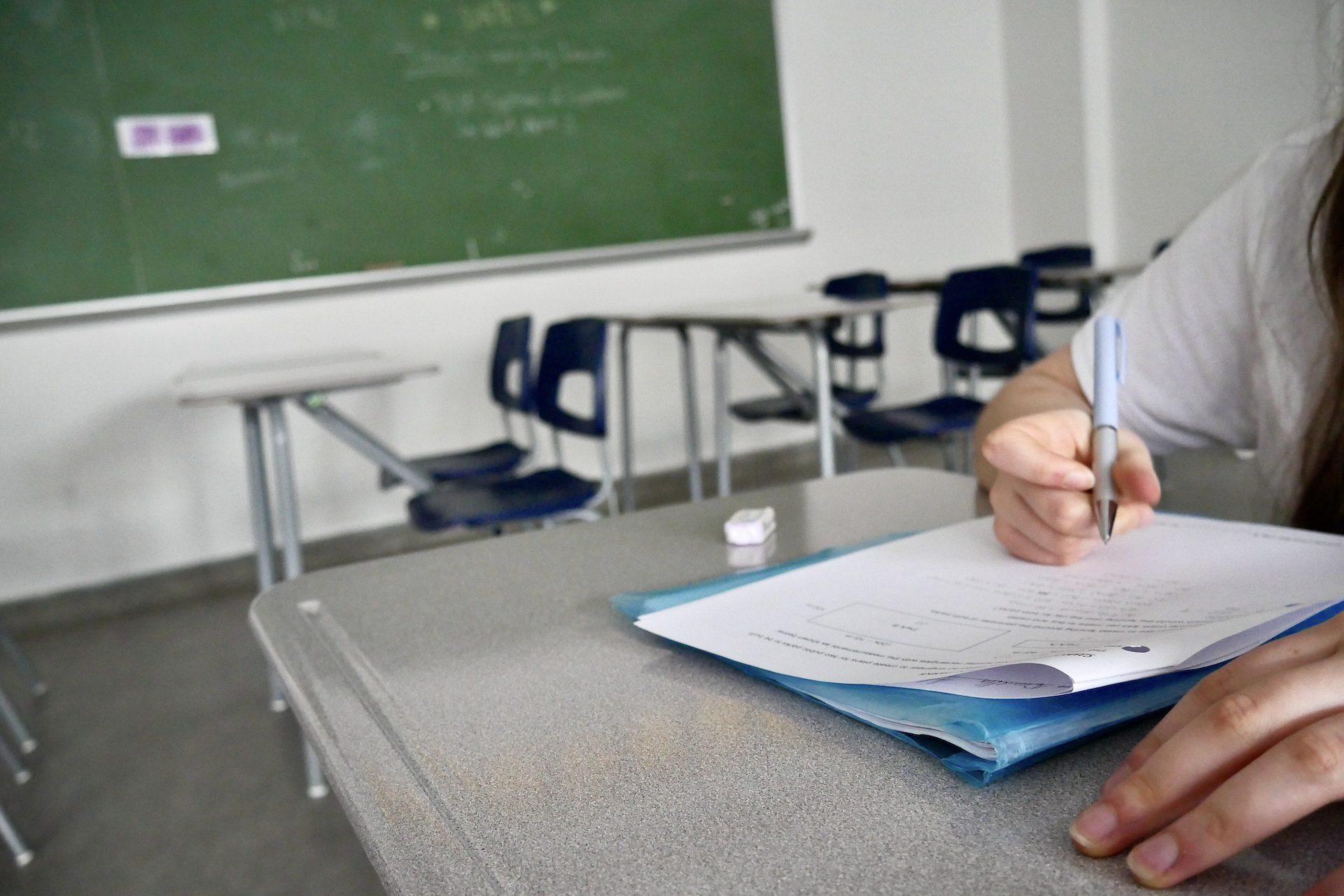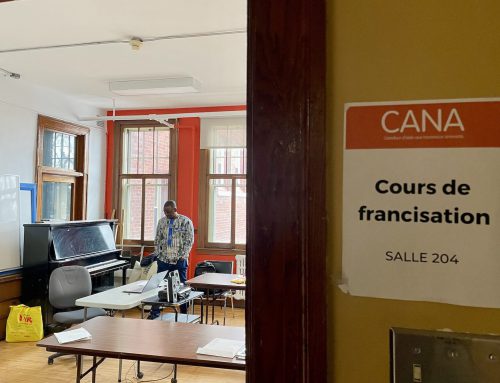BY Olivia Integlia & Lucas Matthew Marsh
Victoria Rebelo learned quickly that she had to punch her bullies or be punched.
“I had to fight to defend myself,” she says.
In high school, Rebelo, 23, experienced severe physical, verbal and online bullying.
“I’m going to beat you up, I’m going to burn your hair,” she remembers being told. “Those are verbal threats, but then they become a reality when you’re in the large free area during lunch.”
Desperate to find a safe school environment, Rebelo says she changed schools four times.

Victoria Rebelo revisits Phoenix Alternative High School, the only school she says she felt safe in. Photo by Olivia Integlia.
For Rebelo, the school’s administration played a big role in the abuse she faced.
“There are teachers everywhere, but nobody does anything about it. Instead of giving solutions they just told me to leave,” she says.
Rebelo also remembers many occasions when teachers and administrators questioned her about what she had done to warrant the abuse she received.
Rebelo grew up to be a dance teacher and an educator for children with special needs. “I wanted to play a role in there being positive support towards students since I didn’t get as much support as I should have,” she says.
Rebelo is far from the only victim of bullying in Quebec schools.
A 2022 study conducted by Statistics Quebec found that one in 10 people experience bullying or cyberbullying, with teens aged 12 to 17 being particularly at risk.
In the fight against bullying and violence in schools, the Government of Quebec created the position of a National Student Ombudsman in 2022. The mechanism became fully operational in August 2023.
“The Act Respecting the National Student Ombudsman is a new law that provides a framework for the processing of complaints of complex situations within the school system,” says Maïa Aziz, the Regional Student Ombudsman of the Lester B. Pearson (LBPSB) and Marguerite-Bourgeoys school boards.
Her role is to act as a neutral intermediary to investigate concerns raised by parents or students.
Jean-François Bernier is at the helm as the appointed National Student Ombudsman. He helped organize the foundational aspects of the law and appointed 17 Regional Student Ombudsmen.
Distribution of regional student ombudsmen across Quebec school boards. Map by Olivia Integlia.
This move extends the concept of student ombudsmen, previously seen at various Quebec universities, to a broader educational context operating at a provincial level.
There are three steps that parents and students must go through before a Regional Student Ombudsman involves itself in a situation, explains Aziz.
“The student or the parent who's not satisfied with the service first should address it to the school, to the person concerned or their direct superior,” she says.
Aziz adds that the law requires school administrators to respond to the complaint within ten working days.
If the complainant does not hear back or feels unsatisfied with the proposed solution, then they must address the complaint to the institution’s designated complaints officer, she explains. At this step, the issue must be addressed within 15 working days.
Only after these two steps can a parent or student utilize this new governmental body.
Robyn Dalton, executive director of LOVE Quebec, an organization aiming at violence prevention amongst youth, believes that a student ombudsman is an important resource for students and parents to turn to when violence or bullying occurs in schools.

Senior Program LOVE Quebec Coordinator Oliver Zakhour runs a workshop at Parkdale Elementary School to foster a safe space, allowing students to develop a sense of belonging. Photo by Olivia Integlia.
Dalton says she has seen many bullying complaints fall through the cracks due to the absence of a formal process for addressing the issues.
“Having a clear process in place and then having school, staff and administration all be on board and understand what that process is, […] those are winning conditions,” she says.
“If the parent is not satisfied with the conclusion at that level, then they come to me, and the law says that I have up to 35 days to review the situation and render a written conclusion and, if appropriate, recommendations,” explains Aziz.
Aziz reports that, in the first six months of the law’s implementation, 580 of 2,600 total requests had been addressed by the student ombudsmen across the province.
Complaints related to sexual violence are the one exception in which these steps do not need to be followed, she adds.
Universities has been greatly affected by sexual violence on campuses. Advocates are now pushing for change. Video by Lucas Matthew Marsh.
“Anyone can make a report if they believe that there has been a situation of sexual violence within a school directly,” says Aziz.
The reason for this is to prevent unnecessary delays and avoid victims repeating their testimonies over and over, she explains.
Investigating a complaint involves speaking to the parties involved, including parents, students, administrators and the school service centre. Aziz may also consult professionals outside the school. In the end, the institution's director must respond to the conclusions within ten working days.
“If there are recommendations that are accepted, I stay in the picture until those recommendations are put in place,” says Aziz. “So far, collaboration has been excellent.”
In the first six months of operation, seven reports had been made involving the LBPSB.
Darren Becker, a spokesperson for the LBPSB, says that all recommendations have been implemented. Among them, he says that two contained recommendations about modifying and informing parents of a school’s Anti-Bullying, Anti-Violence plan.
The recommendations also put in place support plans and clearly define the roles and responsibilities of staff.
George Manoli is a retired police officer who has been running hands-on learning programs for bullied students since 1982. He anticipates some shortcomings.
“As a parent, what are you going to do when your kid says, ‘I've been bullied’?” Manoli asks.
Though he believes the ombudsman is a great mechanism, it does not provide immediate relief to a child who no longer wants to go to school, or may be having nightmares or suicidal thoughts, he explains.
Manoli teaches his clients how to defend themselves against their bullies.

George Manoli runs through bully scenarios and assertiveness tactics with student Giordano Narcisi. Photo by Olivia Integlia.
“When we're dealing in an intimidating situation, we are dealing with sending a message to the bully,” he explains. “Standing up for yourself is based around sending the body language [and] sending the message [that], ‘If you mess with me, you're going to pay a price,’ without touching [the bully].”
Reflecting on her experience, Rebelo says she wishes programs and initiatives like these had been available to her as a student.
She also believes that the National Student Ombudsman will prevent the escalation of situations in schools.
“It's a good initiative,” she says. “It's easy to sweep something under the rug, but it's not easy when you have to take accountability for the changes that you make.”




